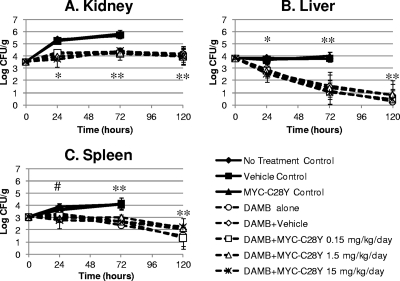Fig. 2.
Quantitative cultures (log CFU/g ± 1 standard deviation) of kidneys, livers, and spleens of neutropenic mice with systemic candidiasis that were treated for 24, 72, or 120 h with 1.4 mg/kg/day of DAMB alone or in combination with 0.15, 1.5, or 15 mg/kg/day of the Mycograb C28Y variant (Myc-C28Y). Animals in the no-treatment control, vehicle control, and the Myc-C28Y monotherapy control arms that survived beyond the 24-h time point were euthanized after 48 h of infection for progressive disease and were included in the 72-h time point group. The quantitative culture results in the kidneys, livers, and spleens at the 72-h time point of the three control arms were used as comparators for the data derived after 72 and 120 h of therapy for DAMB alone or in combination with Myc-C28Y. Doses of the antibody fragment are in mg/kg/day. In each graph, the no-treatment control, vehicle control, and Myc-C28Y monotherapy control results formed the upper cluster of solid curves, which overlap one another. The DAMB-alone arm, the DAMB plus vehicle arm, and the three DAMB plus Myc-C28Y combination arms are shown as the broken curves and formed the second (lower) cluster of curves. The Tukey-Kramer test for multiple comparisons showed that the DAMB, DAMB plus vehicle, and the three DAMB plus Myc-C28Y groups were statistically significantly different than the three control groups at 24 h (*, P < 0.05), while the DAMB-containing arms were similar to each other (P > 0.05). The Tukey-Kramer test for multiple comparisons showed that the DAMB, DAMB plus vehicle, and the three DAMB plus Myc-C28Y groups were statistically significantly different (P < 0.05) than the three 72-h control groups, while the DAMB-containing arms were similar to each other (**, P > 0.05). The Tukey-Kramer test for multiple comparisons showed that the DAMB plus 1.5 or 15 mg/kg/day of Myc-C28Y groups were significantly different than the three control groups at 24 h (#, P < 0.05), but not from the other experimental groups.

